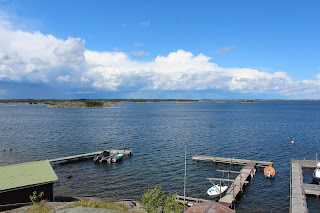Yesterday we visited Gripsholm Castle. We seem to do this sort of thing once or twice on every trip, but more than that and they all start to blend together.
Gripsholm was named for Bo Jonsson Grip, who built the original in the 1300s. Very little remains of that...it was a cloister for awhile, and then in 1537, King Gustav Vasa ordered it renovated and expanded as part of a new national protection system. It has been extensively added to, redecorated, and generally messed with ever since, but bits and pieces dating back to this period do still exist.
It was King Gustav Vasa's primary residence during much of his reign, and then became a sort of Dower House for widowed queens...Queen Maria Eleornora and Queen Hedvig Eleornora lived out their lives there in the 1600s.
A new beginning came in the 1700s, with King Gustav III, who was passionately interested in history and wished to surround himself with it. He brought the court there, rather to their dismay, as they perceived it to be uncomfortable and outdated. The King's other great passion was theatre, and he had one built in one of the Renaissance towers, now called the Theatre Tower. It was an architectural challenge to build a functional theatre in a round tower, five stories up, and one of the castle wings had 3 stories added to it, in order to provide backstage areas and dressing rooms. Gustav III was also the king responsible for the theatre at Drottningholm Palace, still in use today. We'll put the theatre into a separate post, for those interested.


Runestones...they say things like "So-and-so had this carved in honor of....."


Gripsholm from the pier in Mariestad


From the back side Mariestad


Entryway Entryway ceiling


Canons captured from Russia in the 30-Year’s War….they’re called The Sow and The Boar




Inner courtyard


One of the original bedrooms….Gustav Vasa’s, maybe?

Thick walls for good defense


And looooong hallways…..


Some truly amazing woodwork!!


Inlays of various woods And fancy fittings!

A bedroom fit for a princess! All of the hangings were
yellow originally, but some have faded.



Public rooms, reception halls, and a tower room for playing cards.




































































